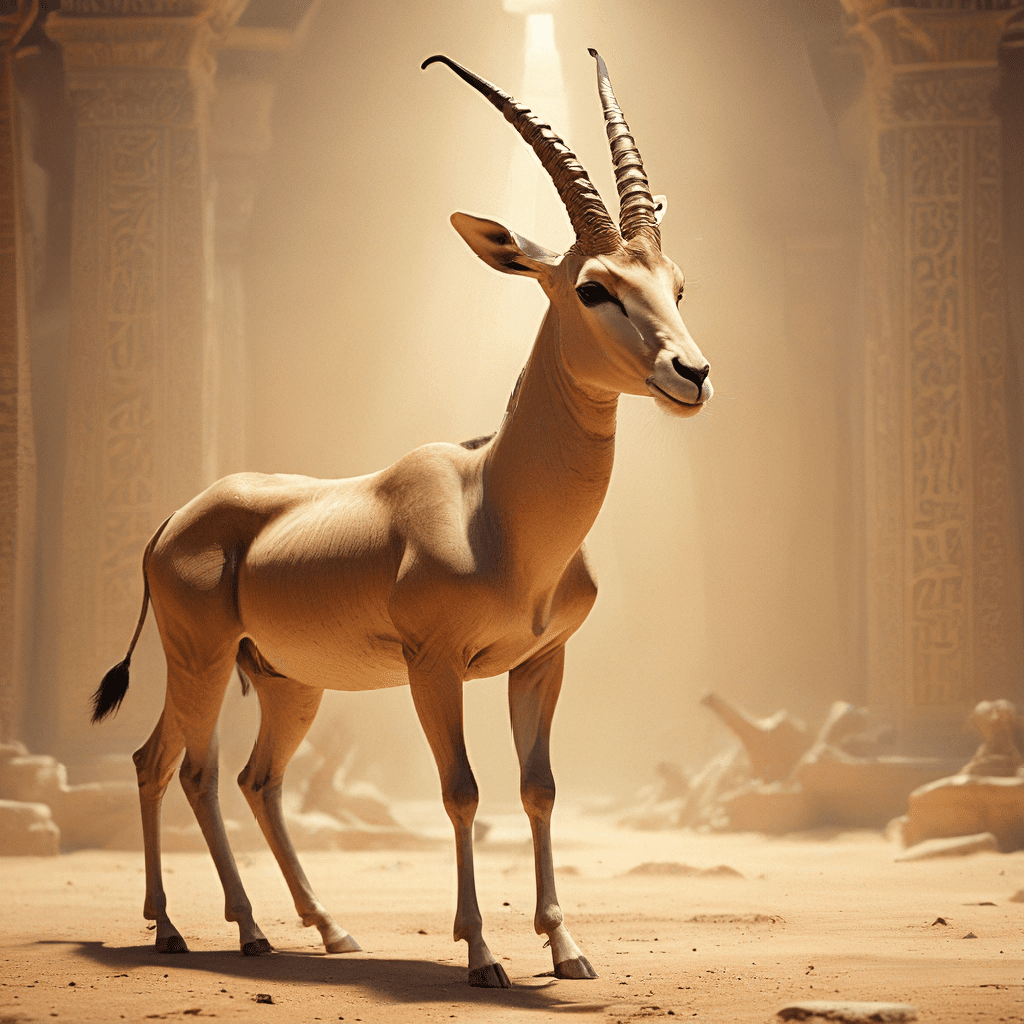## The Gentle Gazelle: A Symbol of Grace and Speed in Ancient Egyptian Culture
1. Introduction: The Gazelle in the Egyptian Landscape
In the vast and arid landscapes of ancient Egypt, a creature of remarkable grace and speed, the gazelle, held a special place in the hearts and minds of the Egyptians. These slender, swift antelopes roamed the plains and deserts, their elegant forms a constant presence in the Egyptian environment. From the fertile Nile Valley to the barren stretches of the Sahara, gazelles were an integral part of the ecosystem, and their presence profoundly influenced Egyptian culture, art, and religion.
2. Physical Characteristics: Grace, Speed, and Agility
Gazelles are renowned for their captivating physical attributes, embodying a harmonious blend of beauty and athleticism. Their slender bodies, long, graceful necks, and delicate features exude an air of refinement. The gazelle’s most striking characteristic, however, is its exceptional speed. These creatures are capable of reaching astonishing speeds, enabling them to outrun predators with incredible agility. This inherent swiftness and grace, a testament to their survival instincts, deeply resonated with the Egyptians, who saw in the gazelle a symbol of swiftness, agility, and the boundless energy of life.
3. Gazelles in Ancient Egyptian Art and Iconography
The gazelle’s presence in ancient Egyptian art and iconography is a testament to its cultural significance. It is frequently depicted in various forms, from intricate hieroglyphs to grand tomb paintings. The gazelle’s graceful form found expression in both realistic and stylized representations. These depictions often showcase the gazelle’s agility and swiftness, highlighting its ability to move effortlessly across the Egyptian landscape. The gazelle’s iconic features, including its horns, slender legs, and elegant form, were frequently incorporated into decorative motifs on furniture, jewelry, and clothing, adding a touch of elegance and refinement to everyday objects.
4. The Gazelle as a Symbol of Beauty and Elegance
The gazelle’s graceful and refined form captivated the Egyptians, who saw in it a representation of beauty and elegance. Its delicate features, slender body, and swift movements were associated with the ideals of beauty and refinement prevalent in ancient Egypt. The gazelle’s graceful presence served as a visual reminder of the beauty that surrounded them, fostering a connection between the animal and the aesthetic values of the Egyptian people. The gazelle’s elegance embodied the harmonious balance and order that the Egyptians believed to govern the universe.
5. The Gazelle in Egyptian Mythology and Religion
In Egyptian mythology and religion, the gazelle held a deeply symbolic significance, often serving as an embodiment of divine attributes or representing various deities. The gazelle’s association with speed and grace linked it to the swiftness of the sun god Ra as he traversed the sky, illuminating the world with his light. The gazelle’s connection to the divine feminine was also prominent, with the goddess Hathor, who embodied love, beauty, and motherhood, being depicted as a gazelle or with gazelle horns. This association highlights the gazelle’s symbolic connection to fertility, abundance, and the life-giving forces of nature.
6. The Gazelle as a Representation of the Divine Feminine
The gazelle’s association with the divine feminine, specifically with the goddess Hathor, was particularly significant in ancient Egyptian culture. Hathor, the goddess of love, beauty, music, and motherhood, was often depicted as a gazelle or with gazelle horns. This association stemmed from the gazelle’s perceived elegance, grace, and fertility. Its swift movements, reminiscent of the wind, also linked it to the goddess’s association with the breath of life, and the gazelle’s ability to give birth to multiple offspring further reinforced its connection to fertility and motherhood. This connection to Hathor elevated the gazelle to a symbol of feminine power, grace, and the vital forces of creation.
7. The Gazelle in Funerary Practices and Beliefs
The gazelle’s symbolism extended to the realm of death and the afterlife. Gazelles were often depicted in tomb paintings, particularly in scenes of hunting or the afterlife. They were believed to symbolize the spirit’s journey into the afterlife, its swiftness and agility representing the deceased’s passage into the realm of the dead. In some cases, the gazelle’s horns were even placed on mummies, signifying the deceased’s connection to the divine and their journey into the afterlife. This practice further cemented the gazelle’s role in funerary rituals and its association with the afterlife.
8. The Gazelle in Literature and Storytelling
The gazelle’s enduring presence in ancient Egyptian literature and storytelling is a testament to its cultural significance. The gazelle’s speed, grace, and agility served as inspiration for tales of heroism and bravery, while its connection to the divine feminine made it a symbol of beauty, love, and fertility in narratives. The gazelle’s symbolic role in storytelling enriched ancient Egyptian culture, providing a rich tapestry of symbolism and shared meaning, further solidifying its place in the collective imagination of the Egyptians.
9. The Gazelle in Daily Life: Hunting, Domestication, and Symbolic Use
Gazelles were not merely symbolic creatures in ancient Egyptian culture but also played a practical role in daily life. Gazelles were hunted for their meat, providing a source of sustenance for the Egyptians. Their skins were also used to create clothing and other items. Although domestication of gazelles was not widespread, their grace and beauty made them desirable companions, particularly for nobility. The gazelle’s horns were also used in crafts and jewelry, serving both utilitarian and aesthetic purposes. This multifaceted role reinforced the gazelle’s presence in the everyday lives of the Egyptians.
10. The Enduring Legacy of the Gazelle in Egyptian Culture
The gazelle’s enduring legacy in ancient Egyptian culture is a testament to its profound influence on the art, religion, and daily lives of the people. Beyond its practical uses, the gazelle’s symbolism deeply resonated with the Egyptians, representing beauty, grace, swiftness, and the divine feminine. The gazelle’s presence in art, mythology, religious practices, and everyday objects continues to captivate our imaginations, providing a glimpse into the rich tapestry of ancient Egyptian culture and the enduring power of symbolism.




